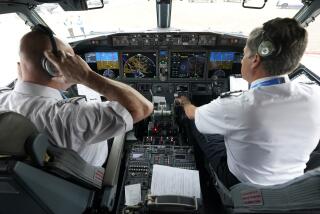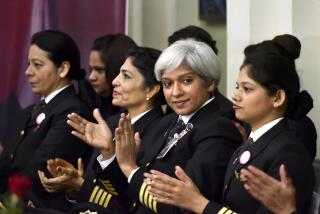Air Traffic Controllers: Some Crave Job’s Pressures : Stress: To succeed, you have to quickly solve three-dimensional puzzles--where mistakes can be fatal.
- Share via
Scott Davies, an air traffic controller in the tower at Lindbergh Field in San Diego, doesn’t feel as quick at noticing quirks of motion in the sky or on the ground. He believes his skills--the mastery of simultaneously watching, speaking, listening and writing--are deteriorating.
“As your age increases, so does your failure rate,” he says soberly. “It’s a young man’s game.”
Scott Davies is 32 years old.
The Feb. 1 ground collision in Los Angeles between a SkyWest commuter plane and a USAir jetliner, in which the tower controller apparently lost track of the position of the planes, left many people wondering why anybody would want to be a controller.
Simple.
With the right set of God-given skills, you can be making up to $70,000 a year by your late 20s, no college degree required. You can have the job security and benefits of the federal civil service. You succeed or fail on your own merits. You’re challenged every day by an unpredictable array of three-dimensional puzzles. And you’ll receive immediate gratification--by the minute in particularly hectic periods.
Of course, there’s the workload, which increases constantly. And your schedule, which changes every week. And the equipment, which is sometimes outdated or unreliable. And this thought, which will cripple you if you don’t suppress it: The smallest mistake on your part can kill people. I work airplanes, you tell yourself. The machinery, not the people, is what you focus on.
“It’s a funny job,” said Dr. Robert Rose, a senior health program adviser at the John D. and Catherine T. MacArthur Foundation who authored the most well-known study of controller stress. “You have to hone your skills for years, but (later) there’s not a lot of other jobs you can get with that talent.”
Rose’s study of 416 New York and New England controllers, published in the late 1970s, found that they were two to three times more likely than others their age to develop high blood pressure. It also found that 55% were heavy drinkers, although changing social mores are believed to have reduced that tendency considerably. Another study found that controllers at Chicago’s O’Hare Airport produced more adrenaline while asleep than other people did while awake.
But the fact is there are a lot of people who like that live-wire sensation of feeling responsible for holding off chaos or bending it back into order. Study after study of job stress has revealed a bedeviling truism: The qualities of a job that make some people anxious are craved by other types of personalities. Another study in the 1970s found that controllers were five times more likely to classify the challenging nature of their work as what they liked best rather than least.
Even now, nearly 10 years after she last directed jets from the tower of Los Angeles International Airport, Crystal Mason revels in the sensations.
“I’ll miss it forever. It’ll never be replaced, once you’ve done it. It’s a high you get. Planes are everywhere and you manage to get through it. It’s a very euphoric feeling, working your way out of trouble. You finish and you wind up sitting in the back--you can’t leave. People are coming up and giving you advice, replaying it, and your head is pulsating. It gives you self-esteem. I didn’t find it stressful. Later I worked as a police dispatcher. That’s stressful. Later I opened a deli. Having employees, that’s stressful.”
Mason left the profession along with 11,400 other controllers in one of the biggest mass firings in American history. Their union, having complained for years that the Federal Aviation Administration was giving them too little say in the structure of the traffic control system and too little money, went on strike in mid-1981. As federal employees, they were legally banned from striking. President Ronald Reagan fired them.
Prospective replacements were easy to come by: 123,000 people applied for the openings. But the process of replenishing the ranks is still going on, and it has dramatically changed the face of the air traffic control profession, which today numbers about 17,000 controllers and supervisors.
Before the strike, most controllers came from the military. Today, few do. Most come with at least some college education--half have a degree. One-sixth of the students at the FAA’s training academy in Oklahoma City, which gives introductory training to about 3,000 students a year, are women. Applicants must pass an academy entrance exam, undergo eight grueling weeks of tutoring, pass a graduation exam (with a failure rate that recently has run 60% or higher) and then absorb two to three years of field training.
The new work force is significantly younger because the FAA won’t hire a controller over the age of 31. The agency views 22 as the optimum starting age.
As a result of these changes, the FAA has about 3,000 fewer experienced controllers--those rated able to perform every job in the tower or other traffic control facility--than it did when the strike occurred.
Studies describe controllers as outgoing and highly intelligent, possessing a rare combination of mechanical aptitude and verbal skills--the latter is equal to broadcasting students, one FAA study showed. They tend to be aggressive personalities fond of acting on impulse.
“Doing it puts you in a different world,” Mason said. “You’re driving down a street and find yourself looking for ‘holes’--looking at the spacing of the cars, the way you train yourself to look for holes in air traffic to insert a plane to land.”
What controllers do is, on its face, fairly simple: From towers or radar facilities, they talk to pilots of planes and make sure that proper “separation” is maintained during takeoffs, flight and landings.
Doing this properly requires the mastery of spatial relations, the ability to visualize a particular chunk of airspace and to then absorb a rapid, ever-changing stream of information about planes flying into that airspace, and finally to advise each plane how its presence may affect another plane. Add bad weather, holiday traffic or a miscalculation by a pilot or two, and suddenly success or failure depends on whether the controller can perform two or three functions at once, shutting out distracting voices while remaining sensitive to relevant ones.
Controllers describe this art as “getting the picture”--knowing where every plane in your assigned sector of airspace or ground is located at a given instant--how fast it’s flying, how high--and being able to anticipate where they’ll be in the next instant. Lose the picture and bad things happen. The more precise your knowledge, the more confidently and quickly you can dictate the movements of two planes--or three, or eight, or nine--that need guidance right now, even when a radar frequency or computer temporarily malfunctions.
Not very many human beings are good at getting the picture, or want the responsibility. But when controllers gripe, it’s less about the stress of the work and more about FAA shortcomings--old equipment and too many inexperienced controllers placed in high-density facilities.
“Sometimes you have to scramble, things get intense for an hour, maybe less, they take awhile to sort out--that’s a lot of stress, but that’s why controllers are who they are,” said Beth Thomas, 41, an operating room nurse turned tower controller at a medium-sized airport near Miami who hopes to move on to work higher-density traffic. “When it’s over with and things come out all right, then it’s like, ‘Wow,’ a tremendous amount of satisfaction.”
When you think of a controller, think of a bartender, says Larry Suppan, who retired a few years ago at 50 after working 15 years as a controller and 13 in various supervisory jobs.
“You go to a busy cocktail lounge, see a bartender setting up eight glasses, and while he’s pouring drinks the waitress is yelling out a new order and at the same time he’s adding up the bill. That’s what you have to be able to: hear, talk and write at the same time.”
But bartenders don’t have to face what LAX controllers call the “Downey Rush,” in which a controller might work 50 or 60 planes in 90 minutes. Experts say that many controllers find this pressure thrilling for a number of years, then get bored, or lose their edge and need to change jobs. Suppan quotes an old interview with Sam Huff, the 1960s New York Giants football star.
“He said that when you’re young you get beat up, banged around in Sunday’s game, then on Tuesday you’re fine and back to practice,” he said. “Two, three years later you notice the bruises don’t go away until Wednesday. Then, after seven or eight years, they don’t heal until Friday and you’ve got a game on Sunday so now you get afraid to get hit, and you start playing more passively, more defensively. You’re thinking too much. It’s time to retire.
“It’s the same with an air traffic controller. . . . When you’re young it’s, ‘Bring them airplanes on, there’s never too many (in the sky at one time) for me to work.’ A few close calls, at first that’s part of your job. But you get older, now you’re starting to think back and analyze. You spread the planes out further. Your efficiency slows down. You become hesitant.” The fun--the sense of mastery, of absolute control--begins to fade.
The difference is that bartenders recover from mistakes easier. Suppan remembers meeting a controller who’d been involved in the crash of a private plane into a mountainside. After several years away from the boards, the controller came back. “From what I heard, he lasted a month,” Suppan says sadly. Researcher Rose remembers a controller who handled a flight that crashed short of the runway in New York in the 1970s, killing 112 people. The controller was unable to work for nine months, then died two years later of an aneurysm.
Some people do make it back. Walter White, the controller on duty when an Aeromexico jet and a private plane collided over Cerritos in 1986, killing 82 people, is back at work as a controller. A subsequent National Transportation Safety Board investigation placed no direct blame on him.
The mistake that apparently was made by controller Robin Lee Wascher at LAX on Feb. 1 is particularly haunting. It haunts everyday citizens because leaving a small plane in the landing path of a jet is like leaving a kettle on the wrong burner.
To controllers, the error is a reminder of the fragility of the skills that often seem so powerful as to be mysterious. “She lost the flick,” says one controller. Translation: the controller forgot where the planes were. “If you’re not able to do it, you tell somebody. That was her mistake. There’s nothing wrong with going down the tubes--it’s how you get out of it.”
Times research librarian Joyce Pinney contributed to this story.






